Nature Notes on the Total Solar Eclipse 8/21/17
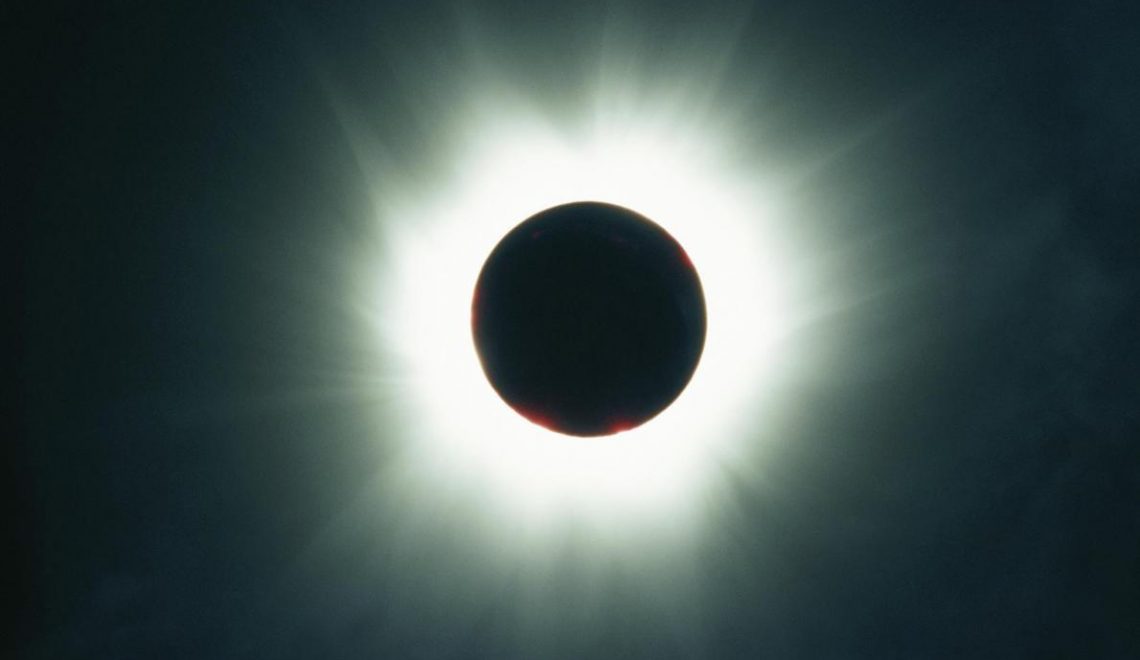
BRNN Event Report
Event held on July 11, 2017
Submitted by Linda Martinson, 7/21/17
Location and Date: BRNN presentation on the Great American Total Solar Eclipse on August 21, 2017, by Bernard “Bernie” Arghiere. The event was on July 11, 2017, from 5:30 to 7:00 pm at the West Asheville Library in Asheville, and was open to the public.
Program Leader: Barbara Harrison Attendance: We had 32 attendees including Bernie.
Event notes: Bernie has been immersed in astronomy for over four decades and has taught several astronomy-related classes and workshops, mainly on the UNC Asheville campus. He spends hours looking up, especially at night, and has traveled to five continents observing the night sky. Bernie received the 2010 North Carolina Champion of Science award from the NC Science, Mathematics, and Technology Education Center. He has been instrumental in the design and construction of three astronomical observatories in the Asheville region is the past president of the Astronomy Club of Asheville. Bernie told us everything we wanted to know about The Great American Total Solar Eclipse of August 21, 2017, and much more!
A solar eclipse happens when the moon passes between Earth and the sun, our closest star, and blocks at least part of the sun as we see it from some areas of the Earth. A total solar eclipse occurs only when the moon complete obscures the sun for a very brief period, known as totality. During the thrilling moments of totality, only the sun’s corona (the lacy, pearly glow of the envelope of gases around the sun) is visible behind the darkened disc of the moon. For 10-15 seconds before and after totality, Baily’s beads are visible — these are the beads of sunlight that shine through the jagged edges of the surface of the moon. As the shadow of the moon begins to completely obscure our view of the sun, these beads of sunshine are blocked out until only one is left — this is called the diamond ring effect and it only lasts about 5 seconds before and after totality. For a heartbeat or two before and after totality, the thin layer of red glowing hydrogen gas around the sun called the chromosphere is visible. Interesting notes: because the sun is a ball of gas with no solid form the solar flares of the sun’s corona are hotter than the sun itself, and the corona spreads out from the sun’s surface about one million miles in every direction. For a short, lyrical description of thrilling moments of totality click on this link: www.mreclipse.com/Totality2/TotalityCh01.html
Images from Astronomy Club of Asheville website: astroasheville.org

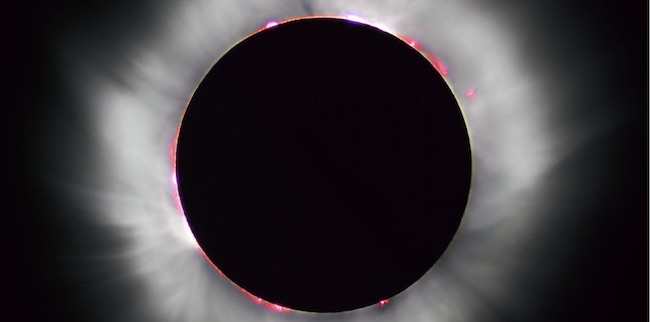
The sun is huge compared to the Earth — the diameters of 100 Earths could be spread across the diameter of the sun, but (thankfully) we are far away from the sun, approximately 90.9 million miles. The moon is much smaller than the sun and the Earth; the diameter of the sun is 400 times that of the moon and approximately 4 moons could be spread across the diameter of the Earth. Even though the sun is about 400 times larger than the moon, the moon can cover the entire disk of the sun when it passes between the sun and the Earth because it is 400 times closer to the Earth than to the sun. These relative sizes and distances mean that a person can stand on the Earth, extend her arm fully holding a pea between index finger and thumb, and cover the disk of a full moon. Note: we also could cover the the disk of the sun with the pea we are holding but staring at the sun would badly damage our eyes.
Relative sizes of the sun, Earth and moon. Reference: barryonenergy.wordpress.com
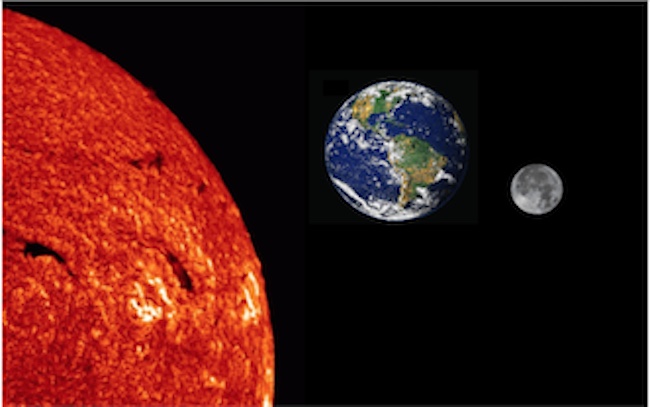
The Earth orbits the sun with a complete rotation taking 365 and a fraction days—defining our year of course. The moon orbits the Earth in about a month. Note: although it looks like it in the illustration below, neither orbit is a perfect circle—both are elliptical and vary in shape for various reasons in real time. The sun’s orbital plane is called the ecliptic but as illustrated below, the plane of the moon’s orbit is inclined to the Earth’s orbit by about 5 degrees. The two orbits cross twice a month, once when the moon is ascending towards the sun and once when it is descending — these cross points are the nodes. If both orbits were in the same plane, there would be two eclipses every month: a lunar eclipse at every full moon phase (when the Earth is between the moon and the sun in alignment) and a solar eclipse two weeks later at the new moon phase (when the moon passes in alignment between the sun and the Earth in its rotation). But because of the geometry of the orbits, there are three criteria that must be met for a total solar eclipse to occur. One criterion is that the moon is at or near perigee, its closest approach to Earth in its elliptical orbit; the second criterion is that the moon is at or very near its new moon phase; and the third criterion is that the moon is at or very near one of the two node points where its orbit crosses the sun’s orbit.
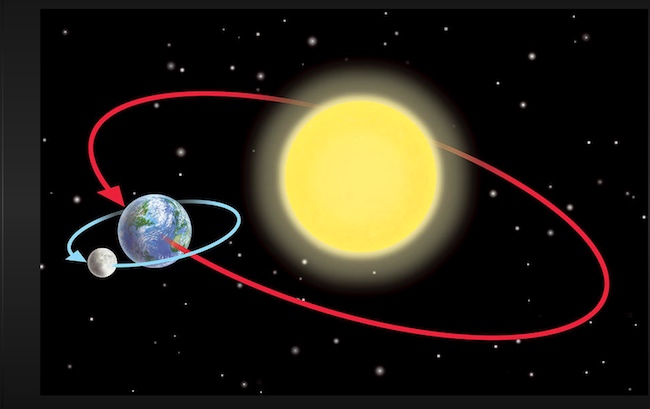 Photo credit: Gary Hincks
Photo credit: Gary Hincks
Although there is not an eclipse twice a month, eclipses do occur in pairs two weeks apart and there are from four to seven eclipses every year — some are solar, some are lunar, some are total and some are partial, but all are exciting in their celestial synchronicity. What is rare, however, is when there is a total solar eclipse right in the neighborhood! There are four eclipses in 2017, i.e., two pairs of eclipses when the new moon and full moon aligned with the lunar nodes. One pair occurred in February, an ascending node lunar eclipse on February 10-11 followed by a descending node annular or ring-shaped solar eclipse on February 26, and there will be another pair in August. On August 7 there will be a descending node partial lunar eclipse followed by an ascending node total solar eclipse on August 21, hailed by many as the Great American Total Solar Eclipse, and this one is in our neighborhood!
On Monday, August 21, 2017, there will be a total solar eclipse visible across the contiguous United States, the first one since February 1979 when it only was visible in the Pacific Northwest. The moon’s approximately 67-mile wide umbral (full) shadow will travel across the United States. beginning on the Oregon coast at about 1:20 p.m. EDT, and traveling at an average speed of 2,300 miles per hour (approximately the moon’s approximate orbital speed) leaving the United States near Charleston, SC at approximately 2:49 pm, just a little over 90 minutes of elapsed time across the continent. In Tennessee, North Carolina and South Carolina, this total solar eclipse will pass over the western portion of the Great Smoky Mountains National Park and in the regions around Brevard, Franklin, and Murphy. In South Carolina, the umbral shadow (totality) of the total solar eclipse will be visible in the areas of Greenville, Columbia, and Charleston.
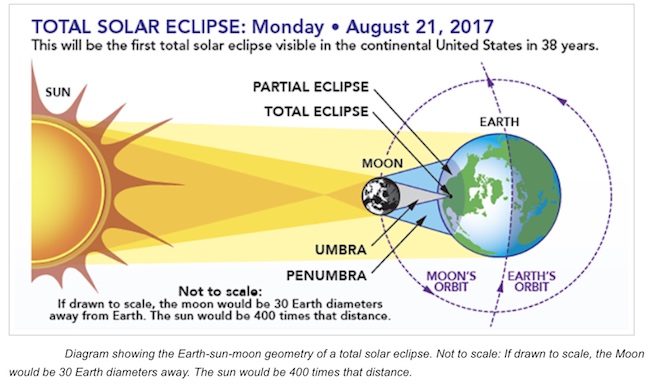
Image from the NASA website
Below are maps of the path of the moon’s umbral shadow, the map of totality, across the contiguous United States In the Asheville area the approximate times for the eclipse range from 1:08 p.m. EDT, the beginning of the partial phases; through the mid-point (totality) of the eclipse at 2:38 p.m. EDT; to 4:01 p.m. EDT, the end of the final partial phases. Although total solar eclipses can range in duration from just a few seconds to about 7 minutes and 30 seconds, totality for this solar eclipse in our region in Western North Carolina will last about 2 minutes and 35 seconds, if you are watching from within the path of totality. The farther you are from the center line of the umbral path of totality, the shorter will be the duration of the total eclipse.
References: eclipse-maps.com astroasheville.org eclipse2017.nasa.gov
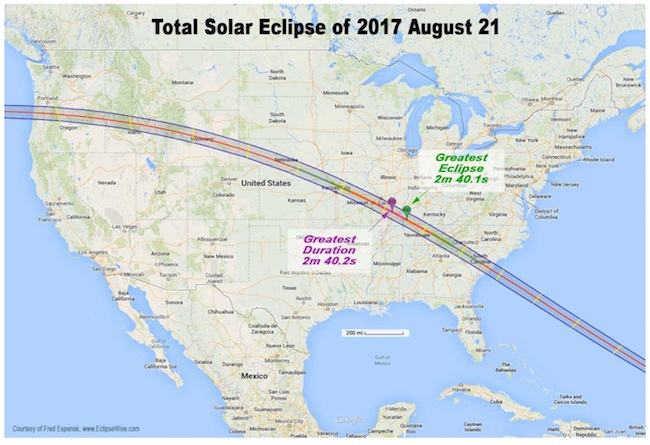
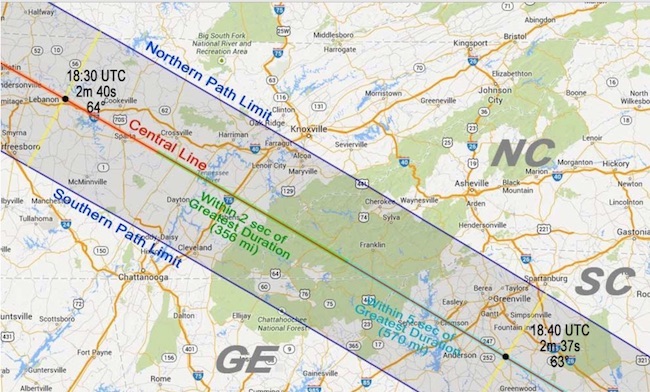
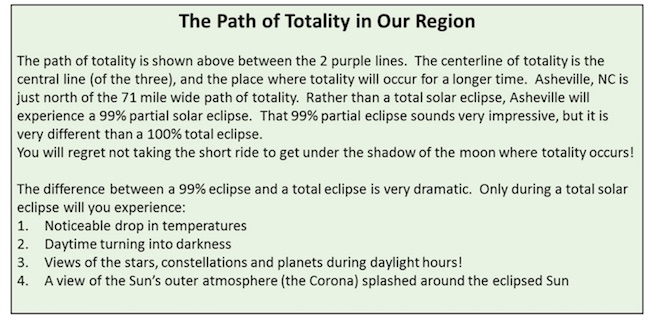
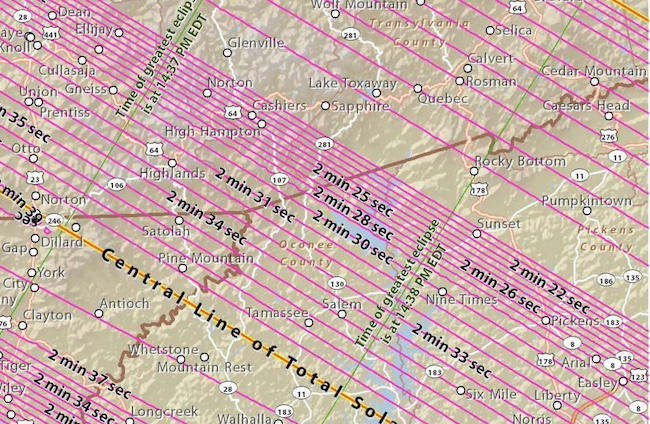
How to prepare to watch the Great American Total Solar Eclipse:
- Plan to travel to a location where you can observe the total solar eclipse — a partial eclipse is, well, just partial. Even 99% total doesn’t really compare to a total solar eclipse.
- Choose a location that isn’t near street lights that will turn on when it becomes dark. Consider the cloud conditions that are predicted — you may have to move around to get a clear view of the sky. If it is cloudy or rain that evening, NASA will be live streaming the entire eclipse!
- PROTECT YOUR EYES! Never look directly at the sun even during the partial eclipse phases without proper eye protection and remember, sunglasses are not proper eye protection! The Astronomy Club of Asheville is giving away safe solar shades for a $2 donation per pair and you also can buy safe protective eye shields online and in several local stores.
- If you are under the path of totality, definitely remove your protective eye shields during the few thrilling minutes of totality. Here is what you will see: the sun’s chromosphere and corona, the stars and constellations, and four bright planets near the sun: Mercury and Mars, Jupiter and Venue.
The image below shows what you should be able to see during the totality phase of the solar eclipse in the North Carolina/South Carolina region. For about 2 1/2 minutes, you will be able to use binoculars to see the stars, planets and constellations that are near the sun during this brief exciting time. Don’t bother trying to bring a telescope; there won’t be enough time to adjust it and remember, totality is the ONLY time you can take off your protective glasses and use your binoculars during the solar eclipse.
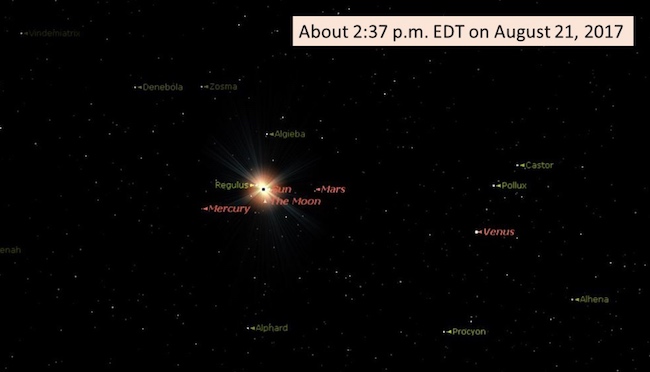
What if you miss it?
Even though total solar eclipses occur on the average of about every 18 months, it is rare to have a total solar eclipse occur in a place on Earth where it can be easily viewed by many people. It is even more rare to have a total solar eclipse occur more than once at the same place on Earth; on the average it only happens once per every 4 centuries. There is, however, another total solar eclipse coming relatively soon to a neighborhood not too far from ours (several hundred miles west but still in the U.S.) on April 8, 2024. Totality for this solar eclipse will be visible in a narrow strip in North beginning at the Pacific Ocean coast, crossing northern Mexico through Dallas, Texas, Little Rock, Arkansas, through Missouri, Illinois, and Kentucky to Indianapolis and Cleveland, then through New York, northern Vermont and New Hampshire and finally the eastern Canada, exiting from the Island of Newfoundland off the Atlantic Ocean coast. Remarkably, the cities of Carbondale, Ill, Cape Girardeau, MO, and Paducah, KY will experience two total solar eclipses within just seven years.
Bernie concluded his presentation by describing two scientific achievements that were accomplished during a total solar eclipse: 1) the discovery of Helium during the total solar eclipse of August 18, 1868, and 2) the proof of Einstein’s General Theory of Relativity during the total solar eclipse of May 29, 1919. If we get real organized, we could duplicate these scientific achievements OR we could just enjoy the few thrilling moments we will be standing in the shadow of the moon reveling in a composite view of the sun, sky and moon that we rarely, if ever, see. For those few minutes we will all be together in universal time and synchronicity, on a tiny corner of our Earth, in our solar system, watching the shadow of our moon reveal some secrets of our sun. It should be totally awesome!
References:
Astronomy Club of Asheville website: astroasheville.org
barryonenergy.wordpress.com
eclipse-maps.com
eclipse2017.nasa.gov
mreclipse.com







36 comments